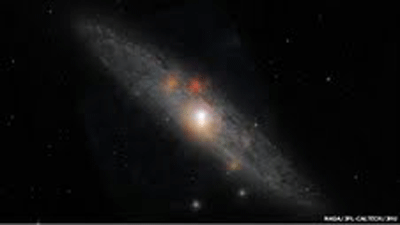A black hole 11 million light-years away has gone dormant, a decade after being spotted consuming cosmic debris.
The black hole lies at the center of the Sculptor galaxy, a so-called starburst galaxy where stars are being born at a prodigious rate.
But the X-ray light corresponding to a black hole’s snack has dimmed markedly.
The find, to appear in Astrophysical Journal, has mystified astronomers because star formation and black hole activity tend to go hand-in-hand.
The Sculptor galaxy – also known as NGC 253 – hosts a central black hole with a mass some five million times that of our Sun – a quarter again as plump as the black hole at the center of our own Milky Way galaxy.
In 2003, researchers using the Chandra space telescope caught sight of the X-rays that correspond to matter spiraling down into the black hole and heating up to millions of degrees.
Black holes are incredibly dense objects with gravity strong enough to trap even light
A ‘medium’ black hole could have the mass of 1,000 Suns but be no bigger than Earth
Supermassive black holes are thought to be at the center of most large galaxies – including ours
But as of mid-2012, the X-ray sky has a new observer: a space telescope called the Nuclear Spectroscopic Telescope Array or Nustar, already a successful black-hole hunter.
Nustar can spot even higher-energy X-rays than Chandra, and in late 2012, both telescopes were trained on NGC 253 – with the surprise finding that the X-ray emission seems to have stopped.
“Black holes feed off surrounding accretion disks of material. When they run out of this fuel, they go dormant,” said Ann Hornschemeier of Nasa’s Goddard Space Flight Center, a co-author on the new study.
“NGC 253 is somewhat unusual because the giant black hole is asleep in the midst of tremendous star-forming activity all around it”.
The subtle interplay between black hole activity and the birth rate of new stars remains somewhat mysterious, but Bret Lehmer of Nasa’s Goddard Space Flight Center, lead author on the paper, said that the Sculptor galaxy could shed new light on these dark galactic corners.
“Periodic observations with both Chandra and Nustar should tell us unambiguously if the black hole wakes up again. If this happens in the next few years, we hope to be watching,” he said.
Source :BBC
N.H.Khider

